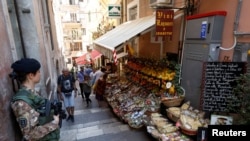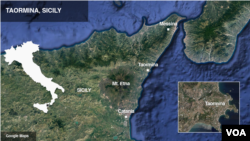The picturesque town of Taormina on Sicily’s Ionian coast, midway between Messina and Catania, has welcomed literary giants and philosophers, monarchs and Hollywood stars.
D.H. Lawrence wrote his travel book Sea and Sardinia while living at Taormina. “Here the past is so much stronger than the present, that one seems remote like the immortals,” he wrote about the town overlooking a dark blue Mediterranean Sea.
But most of Taormina’s 11,000 people, keen to see tourists, especially the monied and famous, would have much preferred if Donald Trump and the other G-7 ‘immortals’ had decided to give their small cliff-top town perched above rocky inlets a miss.
There was alarm among the townsfolk when the then Italian Prime Minister Matteo Renzi more than a year ago picked Taormina as an ideal location for this year’s G-7 summit; the 43rd annual gathering of the leaders of the World’s most advanced economies. Disruption and possible anti-globalization protests were uppermost in their minds. In 2001, when Silvio Berlusconi was prime minister, Genoa in northern Italy hosted a G-7 summit and suffered one of the most violent anti-globalization protests in history.
Local alarm has morphed into anger in the run-up to the summit with infuriated locals complaining about a days-long security lockdown and of the impact on their businesses just as the summer season starts. ”It hasn’t been easy,” admits Riccardo Carpino, Italy’s G-7 commissioner.
In American author Ernest Hemingway’s story The Mercenaries, which takes place in Taormina, the protagonist rhapsodizes that everything on Sicily’s Ionian coast is "all color" and “so pretty that it hurts to look at it.” But what’s been hurting the eyes of locals recently is building renovations and roadworks ahead of the summit.
The Italian government has spent millions repairing roads and shoring up ancient ruins that the cash-strapped state has neglected for years. Streets in the town’s center have often been closed forcing storekeepers to shutter, too. Helicopter pads have been built. Vacationers have been scared off. With days to go before the summit, not all of the planned 700 surveillance cameras have been installed.
Soldiers made their first appearance earlier this month — the early contingents of up to 3,000 troops who will be present to assist 5,000 Carabinieri and local police to protect the summit from protesters and to enforce anti-terrorism measures.
Last week, Italian police chief Franco Gabrielli announced no ships involved in the rescue of asylum-seekers in the Mediterranean would be allowed to dock at any Sicilian port until after the summit’s conclusion. He said the move is designed to ease the burden on security agencies for the two-day summit that starts Friday.
But Italian authorities are as worried about jihadist-inspired terrorism as anti-globalization protests. There have long been concerns about jihadists infiltrating Italy as migrants, seeding themselves among thousands of sub-Saharan Africans making the Mediterranean crossing from Libya. A Moroccan national who arrived in Italy illegally by boat with migrants was arrested in Italy in connection with the March 2015 terror attack on the Bardo museum in Tunis that left 22 dead.
The security buildup is the largest the island has seen since the 1980s when the state waged war on the Mafia following the assassination of Palermo judge Giovanni Falcone.
The security presence, state authorities hope, will ensure nothing like Genoa happens in Taormina — the town will become an inaccessible ‘red zone’ for anyone not involved in the summit or a resident. But trouble could happen nearby. On Tuesday, the so-called Sicilian coordination group against the G-7 said demonstrators will gather in Giardini Naxos, a seaside resort below Taormina - where the summit media will also be corralled - on May 26 and 27 to protest.
“We will be in the streets to give voice to all those who are ignored by this summit,” the group said in a statement. It added ominously: “We announce our desire to make the powerful feel our breath on their necks.”
They’ll likely be joined by protesters from across Europe. State authorities hope to weed out known violent agitators — from anti-globalization provocateurs to jihadists — well before they reach Sicily. The Italian government has suspended Schengen-area regulations and reintroduced border controls and passport checks for travelers entering from other European Union states.
U.S. security demands for President Trump have proven the biggest headache for the Italians. Taormina’s narrow streets are not suited for a smooth escape. The Americans rejected the idea of Trump walking or being transported in golf carts around the town; and the Italians dismissed American requests for ancient streets to be widened for a U.S. cavalcade.
An exasperated town mayor, Eligio Giardina, complained to the Italian newspaper La Repubblica: “Corso Umberto is 900 meters long and the 30 cars they would use would almost occupy it. How would they move?” He added: “They [the Americans] are making us crazy, too.”
Because of security concerns, Trump likely won’t sleep at either of the two main summit hotels but at the U.S. air naval station at Sigonella, south of Catania. From there he’ll be flown to meetings by helicopter — despite some lingering U.S. Secret Service worries about debris spewing from Mount Etna, Europe’s largest active volcano. Etna has been growling.





